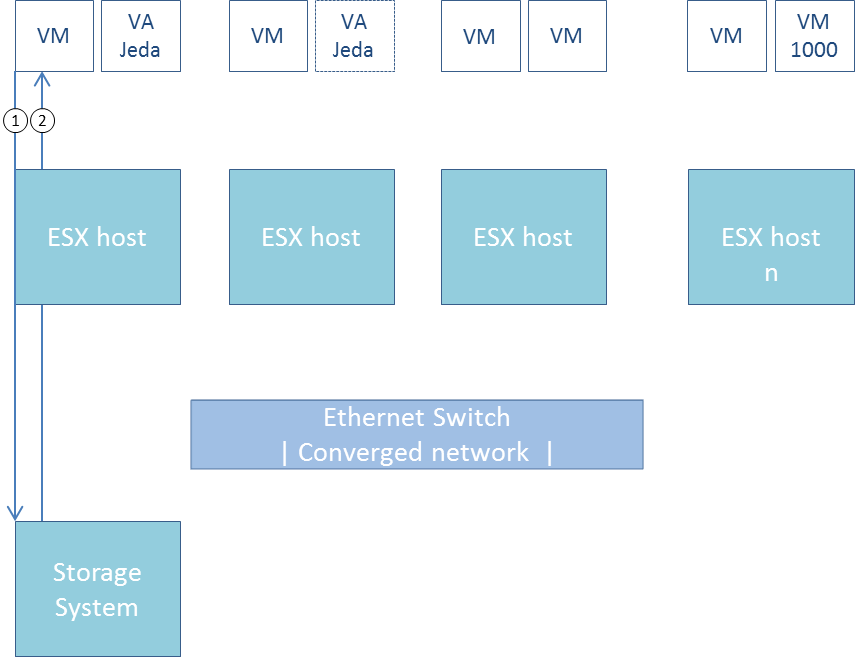 Jeda Networks, interview with Stuart Berman
Jeda Networks, interview with Stuart Berman
Date: 10 Oktober 2013
Jeda Networks CrunchBase profile
Jeda Networks: Software Defined Storage Networking
Following the first part of the interview with Stuart Berman, this article goes further into the inner workings of Jeda Networks. As a prelude to this article, I decided to first go into the significance of SDSN to the IT Infrastructure space. What does it represent and how is it significant?
The importance of Software Defined Storage Networking
Software Defined Storage Networking (SDSN) is a technology that allows customers a far easier and faster way to manage their data Storage in their datacenters. It allows large enterprise customers to very quickly scale up their storage environments and to very easily manage them.
SDSN is a type of Software Defined Networking (SDN), where the networking intelligence no longer resides in the physical network switches, but in a higher software layer. Configuration is done centrally, and new network hardware is quickly configured once added to the network. This allows IT administrators to manage far larger networks with many switches, and allows for great scalability and business agility.
Software Defined Networking is an important step in the race toward the Software Defined Datacenter (SDD). Here, hardware resources of any type: Computing power, Storage, Network are quickly added to an existing Datacenter architecture, that is managed from a central software layer. The benefits; Manageability, Scalability, Business Agility, Cost savings.
Within the Software Defined Networking space, the Storage network has been largely neglected. Usually, a typical datacenter ‘stack’ consists of Servers and Storage that are tied to each other by two separate networks. One network connects the compute layer (servers) that consitutes the Local Area Network (LAN), another network connects to the centralized Storage. The two different networks use different cables, networks switches and have different communication protocols.
Software Defined Networking for the compute (LAN) layer is well on its way, but with their FNC solution, Jeda Networks is the first with a Software Defined Storage Networking (SDSN) solution. They bring the advantages of SDN to the storage network. In doing so they check a box that is required for the advent of the Software Defined Datacenter.
Converged Network Architecture
In addition to offering the benefits inherent to SDSN, Jeda Networks makes use of converged networking.
Converged networking means that both the compute network (LAN) and the storage network are combined and run over the same hardware and cables. The protocol that is used by Jeda Networks for this is Fibre Channel over Ethernet (FCoE).
The advantages of this are a greatly reduced complexity in setting up the physical network, and reduction of capital expenditure for the physical set-up. A disadvantage is that in many cases, customers will have to replace their old (physical) networks.
Coexistence with VMware NSX and other Software Defined Networking solutions
Jeda’s SDSN solution can work alongside different SDN solutions out there so that customers can manage both the compute (LAN) network and storage network from Virtual Appliances in VMware vSphere. According to the CEO Stuart Berman, Jeda Networks can allready coexist with VMware NSX (Nicira). In such a setup, Jeda FNC and VMware NSX operate on different “slices” of the Ethernet.
When a customer runs both Jeda Networks and NSX, the VLANs which define the storage network are controlled by Jeda whereas VMware NSX controls the VLANs which define the “compute” network or LAN. Jeda is looking to integrate with other “LAN” controllers when they converge to a set of standards for integration with other controllers/apps.
Jeda Networks FNC Requirements
Jeda Networks runs in VMware vSphere 5.x as a Virtual Appliance (VA) that supports up to 1000 Virtual Machines (VM). Each VA is backed up by a hot standby that is activated on a different physical host for redundancy. In terms of computing overhead, each Jeda Networks Virtual Appliance requires around 1 CPU of processing power and and 0,5 GB of RAM memory.
Jeda Networks FNC solution runs on Fibre Channel over Ethernet (FCoE) and requires the physical components to be compatible with that. Ethernet Switches, Converged Network Adapters (CNA) have to be certified by Jeda and the customer must have an FCoE storage system. Netapp, EMX and Nexenta are vendors that Jeda Networks work well with.
Further info can be seen on the Jeda Networks Website
I/O Path
The Virtual Appliance (VA) is only involved to establish the path between the host and the storage system and to keep a heartbeat to see if everything is still up. All the traffic is routed directly from the VM through the host to the Storage system. The Jeda Networks Virtual Appliance is not involved at all in the datatrack between host and storage system.
In the above picture; a second Jeda VA is depicted that acts as the hot standby. One VA is capable to handle up to 1000 VMs.
Initialization
To initialize, there is a five-way I/O path that is completed to pick up the instruction set from the Jeda Virtual Appliance. Once the host comes up, it talks to the Jeda VA and is given its storage adress. The host is given the impression it is directly speaking with a Cisco or Brocade FCoE fabric switch and is not aware of the Jeda Networks Virtual Appliance. Once the instructions are delivered to the host, a direct path between the VM and the Storage System is in place. After the initial setup, Jeda is not involved in the datatrack.
The above I/O path depicts the communication when the host initializes and receives the instruction set from the Jeda VA.
Capex and Opex reduction
Compared to Capex expenditure for a Fibre Channel (FC) setup, Stuart estimates that a FCoE setup with Jeda Networks will actually save customers around 50% – 70% in Capex expenditure.
Compared to a typical iSCSI setup, the Capex can actually be up to 10% more expensive. In terms of Operating expenditure, Jeda estimates that they can help their customers reduce Opex up to 70%, especially in large environments.
What does Jeda represent?
In the drive towards the Software Defined Datacenter (SDD) this is a large step forwards. The storage network has been a dark corner in the SDD space and with their FNC solution, Jeda Networks have made an important effort in this field.
Jeda Networks have chosen the FCoE network to perform their Software Defined Storage Network (SDSN) trick on. In doing so they kill two birds with one stone; First, they allow their customers to deploy a converged architecture that reduces the physical requirements and complexity. Second, by virtualizing the storage network and running side-by-side with VMware NSX and soon other SDN vendors, customers are able to virtualize their entire network, from Storage to LAN.
Naturally there are some barriers to consider. For current enterprise customers the FCoE protocol can be an inhibitor, mainly because of existing investments done in Fibre Channel SAN storage. There is also a fair bit of discussion on the topic of FCOE that could stand in the way to deploy Jeda Networks.
Generally speaking, Software Defined Networking, like any other disruptive technology, requires IT organizations to change their ways. Adoptation of disruptive technologies always takes a while.
That said, the potential of the Software Defined Datacenter in terms of business agility, scalability and cost savings is too compelling to be ignored for long. Jeda Networks stepped in a neglected corner in the SDD space and I believe their solution adds real value to the market.
Personally, I am looking forward to the results of the first Beta-tests and hope to follow up this article with an overview of a real-life deployment to give further insight into Jeda’s achievement.
Background and Links
The technical detail in this article is not down to the lowest level, should there be any questions on this please contact me and I will relay your questions to Jeda.
Pros and cons of Fibre Channel and Ethernet storage, Scott Reeves
Vendor meetings at VMworld 2013, Jeda Networks by Scott Lowe
Jeda Networks Fabric Network Controller (FNC) Software Datasheet


Geef een reactie